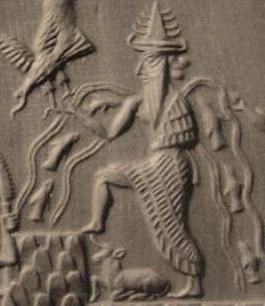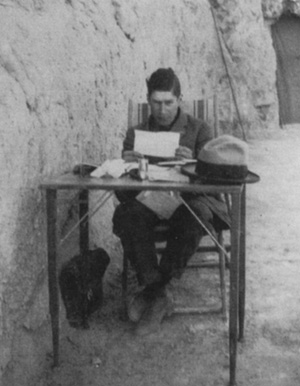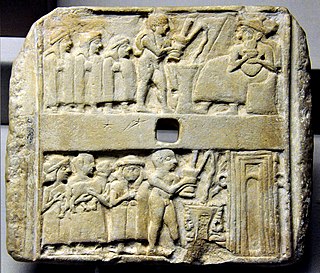Related Research Articles

Enlil, later known as Elil, is an ancient Mesopotamian god associated with wind, air, earth, and storms. He is first attested as the chief deity of the Sumerian pantheon, but he was later worshipped by the Akkadians, Babylonians, Assyrians, and Hurrians. Enlil's primary center of worship was the Ekur temple in the city of Nippur, which was believed to have been built by Enlil himself and was regarded as the "mooring-rope" of heaven and earth. He is also sometimes referred to in Sumerian texts as Nunamnir. According to one Sumerian hymn, Enlil himself was so holy that not even the other gods could look upon him. Enlil rose to prominence during the twenty-fourth century BC with the rise of Nippur. His cult fell into decline after Nippur was sacked by the Elamites in 1230 BC and he was eventually supplanted as the chief god of the Mesopotamian pantheon by the Babylonian national god Marduk.

Enki is the Sumerian god of water, knowledge (gestú), crafts (gašam), and creation (nudimmud), and one of the Anunnaki. He was later known as Ea or Ae in Akkadian (Assyrian-Babylonian) religion, and is identified by some scholars with Ia in Canaanite religion. The name was rendered Aos in Greek sources.

Joseph John Campbell was an American writer. He was a professor of literature at Sarah Lawrence College who worked in comparative mythology and comparative religion. His work covers many aspects of the human experience. Campbell's best-known work is his book The Hero with a Thousand Faces (1949), in which he discusses his theory of the journey of the archetypal hero shared by world mythologies, termed the monomyth.

Mesopotamian religion refers to the religious beliefs and practices of the civilizations of ancient Mesopotamia, particularly Sumer, Akkad, Assyria and Babylonia between circa 6000 BC and 400 AD, after which they largely gave way to Syriac Christianity practiced by today's Assyrians. The religious development of Mesopotamia and Mesopotamian culture in general, especially in the south, was not particularly influenced by the movements of the various peoples into and throughout the area. Rather, Mesopotamian religion was a consistent and coherent tradition which adapted to the internal needs of its adherents over millennia of development.

In Mesopotamian mythology, Ereshkigal was the goddess of Kur, the land of the dead or underworld in Sumerian mythology. In later myths, she was said to rule Irkalla alongside her husband Nergal. Sometimes her name is given as Irkalla, similar to the way the name Hades was used in Greek mythology for both the underworld and its ruler, and sometimes it is given as Ninkigal, lit. "Lady of the Great Earth".

The Genesis creation narrative is the creation myth of both Judaism and Christianity. The narrative is made up of two stories, roughly equivalent to the first two chapters of the Book of Genesis. In the first, Elohim creates the heavens and the Earth in six days, then rests on, blesses, and sanctifies the seventh. In the second story God creates Adam, the first man, from dust and places him in the Garden of Eden. There he is given dominion over the animals. Eve, the first woman, is created from Adam’s rib as his companion.

Etana was the probably fictional thirteenth king of the first dynasty of Kish. He is listed in the Sumerian King List as the successor of Arwium, the son of Mashda, as king of Kish. The list also calls Etana "the shepherd, who ascended to heaven and consolidated all the foreign countries", and states that he ruled 1,560 years before being succeeded by his son Balih, said to have ruled 400 years. The kings on the early part of the SKL are usually not considered historical, except when they are mentioned in contemporary Early Dynastic documents. Etana is not one of them.

In Hittite mythology, Illuyanka was a serpentine dragon slain by Tarḫunz, the Hittite incarnation of the Hurrian god of sky and storm. It is known from Hittite cuneiform tablets found at Çorum-Boğazköy, the former Hittite capital Hattusa. The contest is a ritual of the Hattian spring festival of Puruli.
John Van Seters is a Canadian scholar of the Hebrew Bible and the Ancient Near East. Currently University Distinguished Professor Emeritus at the University of North Carolina, he was formerly James A. Gray Professor of Biblical Literature at UNC. He took his Ph.D. at Yale University in Near Eastern Studies (1965) and a Th.D. h.c. from the University of Lausanne (1999). His honours and awards include a Guggenheim Fellowship, an NEH fellowship, an ACLS Fellowship, and research fellowships at Oxford, Cambridge, Katholieke Universiteit Leuven, and National Research Foundation of South Africa. His many publications include The Hyksos: A New Investigation (1966); Abraham in History and Tradition (1975); In Search of History ; The Edited Bible (2006); and The Biblical Saga of King David (2009).
The religions of the ancient Near East were mostly polytheistic, with some examples of monolatry. Some scholars believe that the similarities between these religions indicate that the religions are related, a belief known as patternism.

Simo Kaarlo Antero Parpola is a Finnish Assyriologist specializing in the Neo-Assyrian Empire and Professor emeritus of Assyriology at the University of Helsinki.
Tikva Simone Frymer-Kensky was a professor at the University of Chicago Divinity School. She received her MA and PhD from Yale University. She had previously served on the faculties of Wayne State University, the Jewish Theological Seminary of America, Yale University, Ben Gurion University, and the Reconstructionist Rabbinical College, where she served as director of Biblical studies.

Henri "Hans" Frankfort was a Dutch Egyptologist, archaeologist and orientalist.
Jimmy Jack McBee Roberts, known as J. J. M. Roberts, is William Henry Green Professor of Old Testament Literature (Emeritus) at Princeton Theological Seminary in Princeton, New Jersey. A member of the Churches of Christ, Roberts attended Abilene Christian University before pursuing doctoral work at Harvard University.

Wilfred George Lambert FBA was a historian and archaeologist, a specialist in Assyriology and Near Eastern Archaeology.

Sumerian religion was the religion practiced by the people of Sumer, the first literate civilization of ancient Mesopotamia. The Sumerians regarded their divinities as responsible for all matters pertaining to the natural and social orders.

A major branch of classical mythology, Greek mythology is the body of myths originally told by the ancient Greeks, and a genre of Ancient Greek folklore. These stories concern the origin and nature of the world, the lives and activities of deities, heroes, and mythological creatures, and the origins and significance of the ancient Greeks' own cult and ritual practices. Modern scholars study the myths to shed light on the religious and political institutions of ancient Greece, and to better understand the nature of myth-making itself.
John H. Walton is an Old Testament scholar and Professor at Wheaton College. He was a professor at Moody Bible Institute for 20 years. He specializes in the Ancient Near Eastern backgrounds of the Old Testament, especially Genesis and its creation account, as well as interpretation of Job.
Firas al-Sawwah is a Syrian writer
References
- ↑ "Rev Professor John Gray". heraldscotland.com. 25 April 2000. Retrieved 21 February 2016.
- ↑ Contemporary Authors: First revision - Volumes 9-12. Gale Research Company. 1974. p. 343.
- ↑ Near Eastern Mythology (Library of the World's Myths and Legends)
- ↑ Data on french BNF